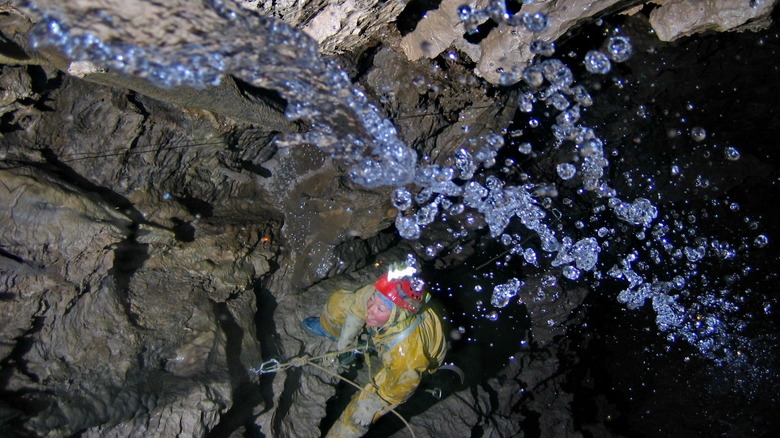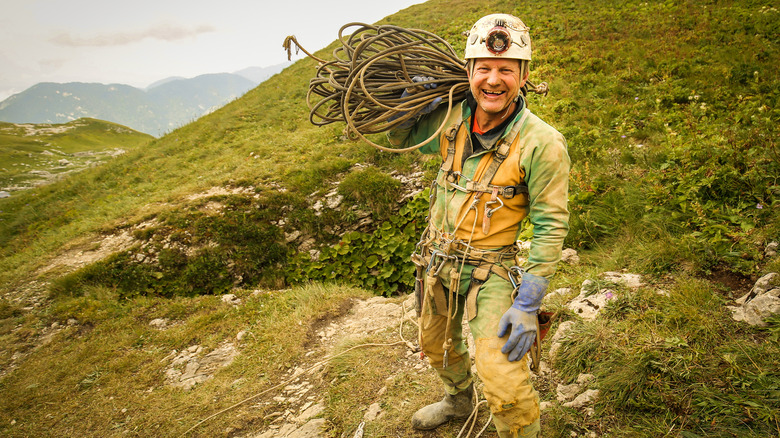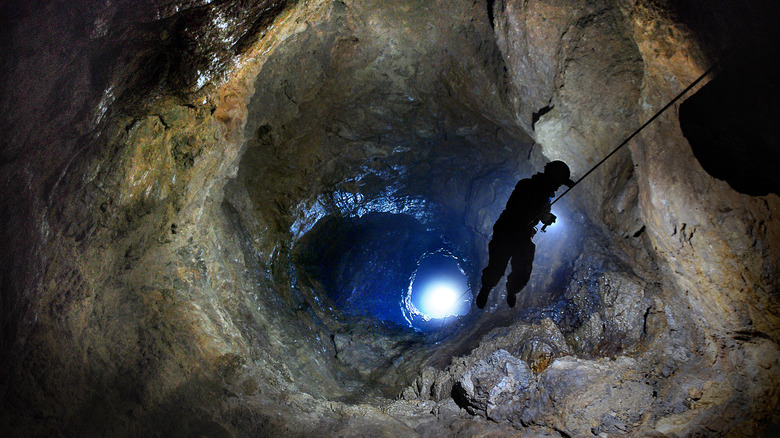Nestled in the rugged terrain of the Western Caucasus, in Abkhazia, an autonomous republic of Georgia, lies Krubera Cave, often called the Everest of caves. With depths reaching 7,215 feet, this enigmatic subterranean giant holds the record as the second-deepest cave on Earth, just behind Veryovinka Cave (7,257 feet deep), also located in the same region. Krubera Cave is a realm where only the most daring venture, a unique challenge to speleologists and adventure seekers alike.
Krubera Cave captures the imagination with its staggering depth and intricate network of passages reaching almost 10 miles. The cave is named after Alexander Kruber, a Russian geographer, while its alternate name, Voronya Cave, means “Crow’s Cave” because of a colony of crows nesting near the entrance. Discovered in 1960, the cave remained unexplored for decades due to technical challenges, extreme depths, and regional turmoil after the downfall of the Soviet Union. Its full scope was only discovered by modern expeditions, some led by National Geographic and others by international speleological organizations, in the early 2000s.
The comparison to Mount Everest is apt not only because of its record-breaking depth but also due to the sheer challenge and danger involved in exploring it. The cave represents the pinnacle of speleological exploration, a subterranean Everest, beckoning the bravest to descend into Earth’s abyss. The ancient cave began developing during the Jurrasic and Cretaceous eras within the Arabika Massif, a limestone mountain block, one of the largest of its kind.
The journey into the depths of Krubera Cave

Yuri Kasyan / Wikimedia Commons
The journey into Krubera Cave is not for the faint-hearted. It starts at a narrow cave opening in the mountains, at an altitude of 7,400 feet, with a slow abseil down. This is a physically and mentally demanding expedition, requiring specialized equipment and extensive expertise. Krubera Cave is known for its claustrophobic, often impassable corridors, enormous vertical shafts, and other treacherous obstacles.
The cave complex is comprised of two branches: Non-Kuybyshevskaya (4,242 feet deep) and Main (7,257 feet deep). However, the deeper you go into this bottomless pit, the more labyrinthine everything gets. Sumps, or water-filled basins, can only be passed with scuba diving gear. The deepest sump has been dived up to 170 feet. Five camp zones have been established by previous expeditions throughout the cave.
Frozen waterfalls, icy chambers, internal lakes, stalactites, and stalagmites adorn Krubera’s interior, creating an otherworldly landscape. The ecosystem is equally fascinating, with unique species, such as crustaceans, insects, and the deepest living terrestrial animal. The isolated environment is characterized by complete darkness, high humidity, and stable but low temperatures.
As one of the most dangerous caves in the world, Krubera is a test of endurance and resilience. The cold, damp conditions, coupled with the constant threat of falling rocks and flooding, make each expedition a meticulous operation. Cavers must be prepared for the unexpected and be adept at problem-solving in this remote subterranean environment — in the case of an S.O.S., help may not come.
Essential preparation for one of the world’s deepest caves

Gergely Ambrus / Wikimedia Commons
Due to the cave’s location and the technical skills required, it’s not a destination for casual tourists. You’ll need everything from food to breathing equipment, tents to scuba diving gear, not to mention rope (and lots of it) — altogether, an expensive and challenging affair. Prospective explorers need to coordinate with speleological groups, ideally with previous Krubera experience, such as the National Speleological Society or the Ukrainian Speleological Association, as they’ve completed multiple treks.
You may wonder how long it takes to explore Krubera Cave — all we can say is, if you want to venture to the depths, you’re in it for the long haul. Some expeditions have been there for two weeks, and that’s just the trip down. Moreover, due to the location of the cave within Abkhazia, a region with a complex political and historical background, reaching the entrance to the cave itself is not simple. You must obtain a visa, either from Russia or Georgia, and any necessary permits and insurance.
The exploration of Krubera Cave represents the extreme limit of human exploration, akin to the challenges faced in space exploration and deep-sea dives. “Even now, we don’t know whether we’ve reached the limit — or if it will go on. We’re pretty sure we’ll eventually go even lower,” said Alexander Klimchouk, one of the cavers who organized a Krubera mission in 2005 (via BBC). For a Jules Verne-esque journey to the center of the Earth, this Everest of caves is your point of descent.

